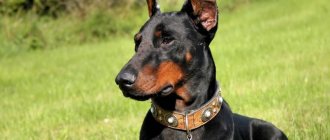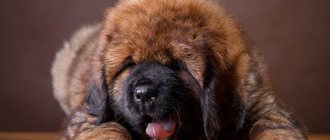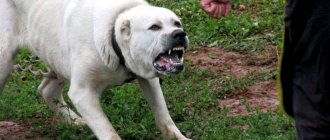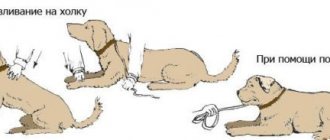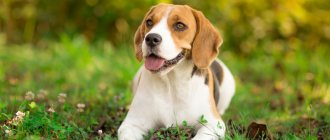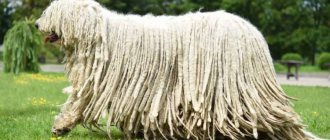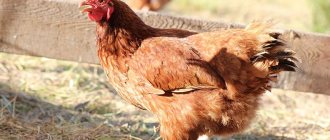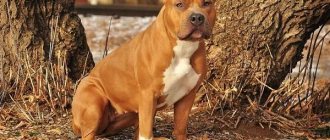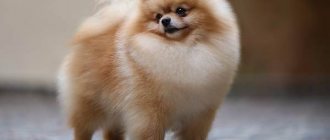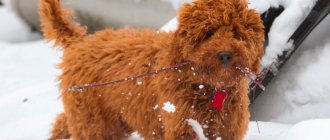The Doberman Pinscher is a smooth-haired working dog breed. The first thing I want to tell you is that this is a very kind, sociable and cheerful dog. However, thanks to her appearance, service in the police and army, metal collars and several films have given many people the opposite opinion. Read to the end and you will understand everything yourself.
| Place | Germany | |
| Time | 1890 | |
| Height | males | 68-72 cm |
| bitches | 63-68 cm |
| 40-45 kg | |
| bitches | 32-35 kg |
Doberman - meaning
The Doberman Pinscher dog, or simply Doberman, appeared in Germany around 1890. The dog received this name for the breed thanks to the surname of the person who selected it - Karl Friedrich Louis Dobermann. He himself called these dogs Thuringian Pinschers. After his death, this breed was called the Doberman Pinscher, and then simply Doberman.
Doberman Pinscher = Doberman
Photos of Dobermans
Doberman Pinscher photo
doberman dog photo
Doberman stands
what does a doberman look like
Doberman breed photo
photo of black Dobermans
white doberman photo
Doberman beautiful photos
adult Doberman
Selection of a puppy
It is best to select a pet in specialized clubs or nurseries. This way you can protect yourself from unnecessary worries, and be confident in the origin and health of your new friend.
If the purchase occurs second-hand through an advertisement, it is better to take an experienced person with you for this task. Be sure to check all documents and certificates from the veterinarian.
Having a pedigree increases the likelihood that you will get a dog with the personality that you liked so much after reading the forums.
At the same time, this also increases the cost. In Russia, prices for Dobermans range from 8 to 100 thousand rubles, and depend on the status of the baby’s parents.
Neapolitan Mastiff - features of the breed and a detailed description of the dog. Character, properties and characteristics inherent in the breed (145 photos)Great Dane - price, description of the breed and main characteristics of the Great Dane. 110 photos and video descriptions of breed standards
South Russian Shepherd - cost and description of the breed. Characteristics of dogs and their maintenance (105 photos and videos)
Doberman - the character of the breed
Louis Doberman - founder of the breed
History of the breed. So that you can better understand whether a Doberman is kind or evil, let us tell you a little history. Karl Friedrich Louis Dobermann became the creator of this popular breed. Doberman worked as a tax collector and in his spare time ran a shelter for stray dogs. While collecting taxes, Doberman needed protection and at that time he could not find a suitable dog for protection. And then he decided to breed the necessary breed himself. At one of the exhibitions, he bought a pair of Old German Pinschers, from which the Bismarck bitch was subsequently born, which was used for breeding. This is one of the few facts that are known for certain. Accurate information about all the breeds that took part in the appearance of the Doberman has not been preserved. And from different sources, data can vary dramatically. Karl Doberman created a dog that was fearless, resilient, fast, strong and did not require special care. An ideal dog for police service, because she also has an excellent sense of smell. Her speed and size did the trick. The fame of the vicious Thuringian Pinschers spread quickly.
Police Doberman Pinscher Club. One of the first Dobermans in service in Russia
Doberman Pinschers became popular as bodyguards and security guards. Otto Geller continued the work of the “father of the breed”. He was engaged in softening the character of the Doberman and was very successful in this. Which had a positive impact on their further spread throughout Europe and then throughout the world. It is thanks to him that we now know Dobermans as they are. good, kind and obedient dogs. By the way, Dobermans were brought to Russia in 1902 and of course they immediately became popular search dogs.
Doberman Day
It was on this day in 1958 that the International Canine Association decided to officially assign this name to the breed, instead of the previous one - “Doberman Pinscher”. And today, Dobermans are the only dog breed that bears the name given by the surname of the “godfather” of all Dobermans - Ludwik Dobermann.
Health
Characteristic diseases
Although Doberman Pinschers are not susceptible to eye diseases such as cataracts and allergies , they do have several hereditary diseases.
In Europe, there is an increase in the incidence of heart disease (cardiomyopathy) and gastric volvulus.
American breeders are faced with the emergence of new hereditary defects in this breed: hypothyroidism (underfunction of the thyroid gland), Von Willebrand's disease (blood disease), Wobbler's syndrome.
Disadvantages that do not affect overall health include:
- defects of the dental system (lack of incisors and premolars, malocclusion);
— pigmentation defects (any spots not provided for by the standard).
The Doberman Pinscher is easy to train and then happily follows the owner’s commands.
Vaccinations
The first vaccination is carried out before teeth change.
Before 3 months of age, the puppy must be vaccinated against: - distemper; - leptospirosis; - parvovirus infection.
Before the first vaccination, puppies must be given anti-worm medications.
You can read about how to give your dog a pill here:
A sweeping, elastic step, an aristocratic posture and a proud head position - all this is the Doberman Pinscher
Pros and cons of the Doberman
Pros:
- Friendliness and peacefulness are the most striking character traits of this breed;
- Doberman and children - dogs truly love to play with kids and show great affection for them;
- Poise, intelligence and strength;
- Excellent trainability;
- External attractiveness of the dog.
Minuses:
- Aggressive in defending territory – Dobermans tend to defend their family and their territory. It will never attack unless its owners are, in the animal's opinion, in danger;
- The need to demonstrate the owner’s strong character for harmony in the “dog-owner” relationship. However, this is a conditional minus, since a strong character of the owner is required for any breed;
- Pet's psyche and wayward character.
Upbringing
Due to their ingenuity, Doberman Pinschers learn everything perfectly even in puppyhood. There is no better pastime for them than studying and working.
Despite the readiness for training, it is worth paying attention to the condition of the pet. If he is tired or bored with classes, you should not burden him. Otherwise, next time he may become stubborn.
Also, you cannot use physical force and rudeness towards the dog, otherwise this may add unnecessary anger to his already difficult character.
Doberman - description of the breed
Let's look at the breed standard, relevant for the summer of 2022. The Doberman breed standard was adopted on December 17, 2015. Below is a brief description, an approximate translation of the official standard.
Head
When viewed from above, it appears as a blunt wedge.
Forehead
flat, the transition from the forehead to the muzzle is small, but clearly visible.
Muzzle
deep, fairly wide, with tightly fitting lips.
Teeth
white, scissor bite.
Eyes
medium size, dark. For brown and ash dogs, lighter shades are acceptable. Protruding eyes are a fault.
Ears
left natural and of appropriate size (FCI-St. N° 143 / 12/17/2015). They should be located on both sides at the highest point of the skull and fit perfectly to the cheeks.
Neck
Set on high, dry, muscular. A short, thick neck, a dewlap attached to it are defects.
Withers
tall and long, well developed.
Back
short, strong. The loin is elastic, muscular, short, slightly convex.
Croup
wide, sloping.
Breast
moderately wide, oval in shape, reaching to the elbows; barrel-shaped, flat, narrow chest is a defect.
Stomach
tucked up, forms a beautiful curved hem line.
Forelegs.
The angle of the glenohumeral joints is about 100°. The forearms are straight and vertically directed. Elbows pressed to the chest, looking strictly back. The wrists are wide and strong. The pasterns are short, elastic, set almost vertically. Paws are arched, in a ball. The muscles of the forelimbs are prominent and dry. Incorrect angles of joints, twisted elbows, clubfoot, dislocation, lack of muscles are defects.
Hind limbs.
The hips are wide and muscular. The hock joints are dry and strong. The hocks are set vertically. The shins are quite long and set obliquely. Faults: closeness of hock joints, incorrect angles of articulations, dewclaws.
Tail.
Remains natural (FCI-St. N° 143 / 12/17/2015) and ideally carries high in a slight curve.
Doberman movements
light, elastic. The step is free and sweeping. The run is easy, beautiful, fast. Ambling is a vice.
Wool
short, stiff, shiny, tight-fitting.
Color
black, dark brown, with rusty red, always clearly marked, having a certain pattern of tan marks. Faults: soft and wavy coat. Light or darkened tan marks, white markings, thick, visible undercoat.
The tail and ears are NOT docked (FCI-St. N° 143 / 12/17/2015)
Dobermans live up to 16 years .
Since the ears are not cropped, there are no problems with the placement of the Doberman's ears .
Anatomical indicators
The Doberman's physique is recognizable in the photo at first glance. A well-developed torso with a low-set rear creates the effect of a born fighter. The chest reaches in depth up to half the height of the dog at the withers.
The muscles of both the front and hind legs are well developed. Relatively short lumbar region.
With proper nutrition and sufficient physical activity, the relief of muscles throughout the body is clearly visible, even on a fairly long and slender muzzle.
Height at the withers is 63-70 cm in females, and 67-73 cm in males. The body weight of females varies from 30 to 37 kg, males - 39-46 kg.
There are also mini Dobermans, identified as a separate breed - decorative dogs, outwardly no different from ordinary ones, except for their actual size.
Doberman colors
Although only two colors are indicated in the description of the breed, walking around the city you can see a variety of colors, we found the most common ones on the Internet.
white Doberman or albino Doberman
black doberman
brown or chocolate Doberman
red doberman
blue doberman
Related article:
Dangerous dog breeds - lists of the TOP 10 breeds abroad and in Russia . Perhaps you like a certain breed and want that particular dog, but is it on the list of dangerous dog breeds? You can find out about this by reading a separate article, where a list of aggressive and angry dogs is published.
Types of Dobermans
- european doberman
- American Doberman
- sometimes the Russian Doberman is also distinguished
Similar breeds:
- german pinscher
- miniature pinscher or mini doberman
Left: American Doberman, Right: European Doberman
Apart from slight differences in appearance, American and European Dobermans also have slightly different personalities/temperaments.
American Dobermans are very affectionate, tend to jump on their owners, and have a goofy behavior reminiscent of Golden Retrievers.
European Dobermans love all family members, but for this reason they are more wary. Sometimes their excessive care causes a number of problems. These dogs are more energetic and always give their best. Larger version of the Border Collie. This is a plus for a working dog, but a minus for an apartment companion dog.
German Pinscher. Sometimes called the German Doberman. Considered the progenitor of the Doberman Pinscher. In appearance they are closer to the American one, but the coloring is close to the European one. The German relative is medium in size, ideal for apartment living.
The Miniature Pinscher or Mini Doberman is absolutely identical to its counterparts, and the main difference is only the size.
The so-called Russian Dobermans are similar in every way to their German relatives, since it was from there that they were brought to us in Russia.
History of the origin of the golden retriever
English aristocrats are passionate fans of hunting. In the 19th century, similar events involving baiting, catching game, and shooting birds were common among the British and Scottish secular elite. Going into the forests and swamps for several days, the venerable sirs boasted to each other about their guns, trophies, thoroughbred horses and dogs.
However, at that time there was a lack of truly fast, dexterous four-legged hunters capable of any forays after prey through tall thickets or difficult water obstacles. Thus, a huge demand has developed for pets with pronounced hunting characteristics.
According to one version, in the 1860s, a certain Lord Tweedmouth acquired Russian Shepherds at a circus performance and began breeding new species through mating and crossing. But these were just rumors created by the aristocrat himself in order to attract the interest of others to his person. After some time, it turned out that the golden beauties have completely different roots.
In the 1940s, then-famous dog handler Elma Stoneks, using Lord's records from the 1860s to the 1890s, revealed the real family ties of the new dogs. The animals have the genes of Labrador, Bloodhound, “water” tweed spaniel and black retriever. After numerous matings, the pets acquired their own special color, became more resilient, active and intelligent, and also ceased to be afraid of water.
In the 1920s, goldens were distributed throughout the West, in the United States, and Canada. Overseas, dogs with a rich, dark-golden coat were more valued. In the 1960s, the breed was officially recognized and registered according to all standards.
Their descendants appeared in Russia only in 1989. Alexey Surov brought them from the USA. And in the 1990s, after the collapse of the Soviet Union, the first Russian retriever puppy was born.
Diseases of Dobermans
Dobermans are generally healthy and strong dogs. However, they are prone to the following diseases:
- Hip dysplasia
- Elbow dysplasia
- Bloating (volvulus)
- Compression of the cervical vertebrae (Wobbler syndrome)
- Dilated cardiomyopathy
- Hypothyroidism
- von Willebrand disease
- Melanoma
- Cutaneous histiocytoma
- Lipoma
- Fibrosarcoma
- Hair loss
- Cataract
- Entropy
- Diabetes
- Lick granuloma
- Chronic hepatitis
- Portosystemic shunt
Keeping a Doberman. At home or on the street?
two Dobermans
You can never say exactly where you should keep a dog: at home, in an apartment, or vice versa in the yard on the street (of course, except for small decorative breeds of dogs, everything is obvious here). On the one hand, a dog is comfortable in a house or apartment, a soft sofa, favorite toys, always clean, but you won’t get much speed.
In the yard or paddock there is space, fresh air, the smells of nature, but there is a real lack of human communication. Especially if there is only one dog. No matter how large the yard is, the dog will soon explore it, find the most comfortable place and lie there all the time.
By the way, the editors of our site are categorically against keeping dogs on a leash and on a chain. This is not acceptable in any form and for any animals. The only place where you should tie a dog is to the owner's hand with a leash when walking in public places. But let's return to Dobermans.
Firstly, Doberman needs constant communication with a person. Secondly, like any smooth-haired dog, they are cold in winter and hot in the sun in summer. We can conclude that it will be much better for a Doberman to live in an apartment or in a house. But if you regularly pay attention to the dog and provide comfortable living in different temperatures, then keeping it in an enclosure is possible. The main thing is regular communication with the dog, joint walks and at least minimal training. You don't need much of a Doberman to be happy.
Keeping a Doberman in an apartment is not as troublesome as it might seem. These wonderful dogs require virtually no grooming. Like any other dog of similar size, it should not be bathed more than 2-3 times a year. You can simply wipe with a wet towel if necessary. With frequent bathing, dogs lose the protective properties of their skin and coat.
Dobermans do not shed much; brushing once a week during the shedding period will be more than enough.
The claws will still need to be trimmed periodically.
Chocolate color
Many people unfamiliar with the breed mistakenly refer to the brown and tan, standard coloring of the Doberman . However, true chocolate coloring, which does not imply the presence of tan, is considered a defect in the breed.
If a purebred Doberman whose origin is known has this color, then it is assumed that he still has a tan, but it is very darkened and blends in with the main color of the coat.
NOTE!
With a very darkened tan, a brown Doberman with documents will be considered a purebred dog, but with a purebred dog in color.
If we are talking about a dog of pure chocolate color that does not have documents about its origin, then it should be considered a mestizo.
What to feed a Doberman?
Feeding will also not be difficult. The easiest way is to choose dry food based on your dog's weight. If the food is of high quality and well balanced, this will be enough. Just remember to leave plenty of fresh water for your dog. Doberman Pinschers also eat natural foods very well. The main thing is not to forget that there should be at least 50% meat in a serving of food, and it is better that 3/4 of the bowl is meat. Diversify a little with cereals and vegetables to get vitamins and essential minerals.
Ideally, a Doberman should combine elegance and power. You need to monitor the dog's weight; it is easy to overfeed a Doberman. But the dog should not look like a “bicycle”. It is considered ideal when the dog’s ribs are not visible, but they can be easily felt.
Let's talk a little about specific products; this paragraph is relevant for most breeds.
- Milk. It is better not to give to adult dogs. They simply will not digest it, and they will also receive a decent dose of sugar in the form of lactose. For the same reason, it is better to exclude ice cream.
Pure cow's or goat's milk can only be given to the smallest puppies under the age of 1.5 months (in small breeds) and up to 3 months (in the largest breeds). Only young organisms can digest it and be useful.
- Sweet. Definitely not. Neither adults nor puppies. This also includes chocolate.
- Eggs. Sometimes it is possible, for example once a week. You can either raw or boiled, but boiled is better digestible, just don’t forget to cool.
- Apples and other fruits. Sometimes you can. It’s just very important NOT to give the whole fruit. The seeds, cores, and stalks contain many harmful substances. Give only what you eat yourself.
- Pasta. In general it is possible, but not necessary. There is absolutely nothing in pasta that is essential for dogs. Only if you fill your stomach with at least something. And only boiled, not raw pasta.
How much does a golden retriever cost?
The approximate cost of a pet-class puppy is from 20 to 25 thousand rubles. The price of a golden retriever for a class show is usually in the range from 35 to 50 thousand rubles. Dogs of this group have all the parameters necessary for competitions. Their belonging to the clan is 100% guaranteed. In addition to this price group, there is an even more expensive class costing from 65 to 80 thousand rubles. Such animals are born from interbreeding. In the future, this makes it possible to breed purebred puppies and sell them for a good profit.
Do you like the article? 0
How to raise a Doberman? Doberman training
This is a separate big topic on which you can write endlessly. Therefore, we invite you to get acquainted with the basics of raising Dobermans. And for more detailed information, if necessary, contact instructors or other sites dedicated to education. At the end of this article we have prepared for you some useful links on this topic.
So. Let us immediately note the main character trait of the Doberman - the desire to work. Training Dobermans is a pleasure; they are extremely happy to carry out any instructions from their owner. It brings them joy; they hardly even need additional motivation. Let us just note that the dog must be taken care of. By exercising we mean both physical and mental training. Otherwise, a Doberman left to its own devices will drive you crazy. No dog becomes obedient on its own.
First year. The main thing that is required in the first year of your pet’s life is to take a place in the pack. The puppy needs a leader with whom she feels confident, calm and will happily follow any orders. A dog must be raised by a leader. Don't leave this to your wife or kids unless it's their dog.
The puppy is constantly trying to learn and, if possible, expand the zone of his control. If the puppy wins this battle, you will both end up losing. You will have an uncontrollable dog, and the dog will grow up hysterical, capricious and unhappy. How to avoid this? Here are some tips.
Persistence . If you give your dog any command, make sure it is fully obeyed. If you teach a dog to sit, it should sit even if you have a bowl of food in your hands, even if you have been away from home all day and finally come, even if there are other animals nearby. If you say “sit,” the dog should sit and sit, at least until you switch it to another action, for example, allow it to go to the bowl to eat. Be friendly and patient. Sometimes, in order for a puppy to follow a command not just for show, the command will have to be repeated 40 times.
A command for a tick means that the dog follows the command only in order to get what it wants. For example, you say “sit”, the dog sits down and immediately gets up and wags its tail with impatience. Or he sits on half-bent legs, ready to take off at the first opportunity. Make sure that the dog understands that this will not work with you, if you say “sit” you will have to sit on your butt and calm down.
Every time you think that “well, this is a puppy, he probably doesn’t understand yet, he’ll go anyway,” know that this is what the Doberman was trying to achieve. They are extremely smart and quick-witted. And they know perfectly well what you want from them.
Start raising your puppy from the first days you come home. Don't put it off until later. From the first day, decide what the dog is allowed in the house and what is not. If your dog is not allowed in the kitchen, kick him out of there from day one.
Feeding from the table. Always a sore subject for dog breeders. It’s impossible to resist that pitiful, hungry look of a little puppy! Remember one rule. If you tell the dog “no, you can’t”, and then after half an hour they still give (you or someone else) “here, just leave me alone,” then all is lost. Your word “no” will be fixed in the dog’s head as “no, but if you continue to ask, then yes.” We do not recommend sharing your food with your dog; this almost always leads to the dog starting to climb on the table in your absence.
Patience, endless. In the first year, a puppy of any active breed of dog, including Doberman puppies, will test your patience several times a day. So stock up on them. If you kick the puppy out of the kitchen, he will definitely try to come in again. Once again. And further. And many many more times, he will test you endlessly. “Maybe it’s already possible?” You must be restless and calm about this and continue, continue to drive him out of the kitchen. Until “no” is no longer “maybe.”
Logical and timely. If you were away from home for a long time, and the puppy chewed up your phone charger out of boredom, there is no point in scolding him when you arrive. The puppy will simply be offended by you and will in no way connect your displeasure with his action. Even if you poke your broken charger in his nose. Only by catching him red-handed at the crime scene can you wean the puppy off.
Emotions and friendship. Firstly, you must be the leader of your pack, and secondly, you must be a friend to your dog. You should be fun and interesting with each other. You organize games for the puppy all the time and gradually, completely freely and happily move on to training. This way, training will not be a burden, but a joyful activity for the two of you.
Walking. The most important thing for you to understand is the following. On the street, you are not walking with a puppy, but the puppy is with you. Remember this very important rule. Don't mind your own business on a walk, mind your puppy!
Barking. A fairly common problem in dogs of this breed. Dobermans are very temperamental and inquisitive. Which leads to unexpected barking from passers-by, cyclists, other dogs, or simply something incomprehensible. What not to do: cannot be ignored, cannot be calmed, stroked, or given treats at this moment. What you can do: the most effective thing is to distract the dog with a game, a ball, a toy, a stick, just call the puppy and run away in the other direction.
Motivation . The best motivation for Dobermans is praise. Use your intonation. If something doesn’t work out for the puppy, correct the puppy with a leash or your hands. If the puppy succeeds, always praise him. Do it emotionally. The main difference between Dobermans and German Shepherds is that Dobermans are not capable of routine work. Alternate work with rest. For Dobermans, there is nothing worse than routine or boring waiting.
We study everywhere. Smart Dobermans will quickly understand that you need to obey 100% on the court, but sometimes you don’t have to obey outside of it. Avoid such situations, let the dog understand that he must obey everywhere the same. If you have learned any command with an instructor, make sure that the puppy performs this command exactly the same 1:1 in the park, in the elevator, and at home. This is a fairly common problem when the dog is obedient only where it is taught, for example at home.
